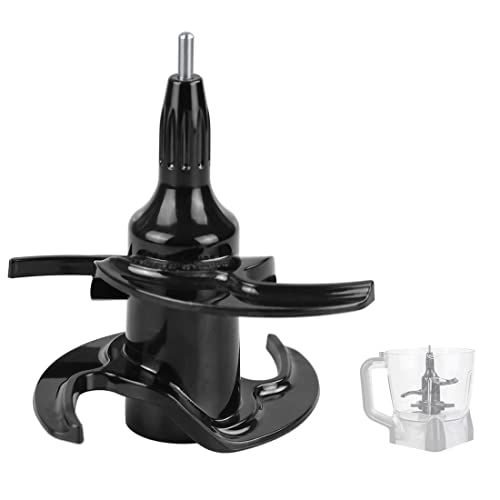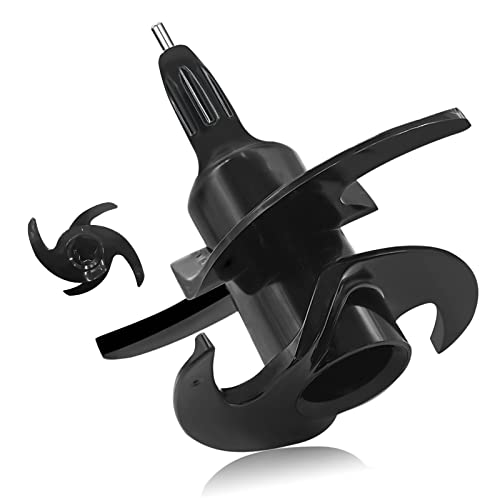As a kitchen appliance with a cult-like following, the Ninja Blender is known for its impressive blending abilities and durable build. While its powerful motor certainly plays a significant role in its performance, the blades are the unsung heroes that make all the magic happen. In this blog post, we’ll be delving into the world of Ninja Blender blades, discussing the different types available and their individual functions. We’ll also offer some tips on how to maintain and upgrade your blades for optimal performance. Whether you’re a seasoned smoothie enthusiast or a beginner in the world of blending, this post has something for everyone. So, buckle up and prepare to discover everything you need to know about Ninja Blender blades!
Table of Contents
Introduction To Ninja Blender Blades
The Ninja brand has become a household name for many reasons, one of which being their high-quality blender blades. The blades are an integral part of the blender, responsible for chopping and blending ingredients to create smooth and consistent textures. The Ninja blender blades are popular because of their superior quality and durability, making them a popular choice for home cooks and professionals alike.
The quality of the blades is a result of the material used in making them. The blades are made from stainless steel, which is a strong and durable material that can withstand daily use and maintain its sharpness over time. The unique design of the blades also contributes to their effectiveness in blending ingredients, allowing for precise cuts and ensuring that ingredients are evenly blended.
Despite the high quality of the blades, it is important to handle them with care to maintain their optimal performance. Cleaning the blades after each use is recommended to prevent the accumulation of food debris or residue, which can lead to dullness and rusting of the blades. Running warm water and dish soap over the blades and wiping them dry with a soft cloth is sufficient for most cleaning purposes.
Overall, the Ninja blender blades are a great addition to any kitchen, offering high-quality results and durability for all your blending needs. Understanding the different types of blades and their functions can also help you choose the right blade for your specific blending needs.
Types Of Ninja Blender Blades And Their Functions
When it comes to blending, the quality of the blades is key. Ninja is a brand that has made a name for itself when it comes to creating blender blades that are not only durable but also effective. There are different types of Ninja blender blades that serve different functions. Understanding particular pupose of the each blade can help you make the most of your blender.
1. Total Crushing Blades
These blades have six prongs and can crush large chunks of ice, fruits, and vegetables with ease. They are perfect for making smoothies, frozen drinks, and snow cones. The total crushing blades are sharp and strong, which means they can handle tough ingredients without any problem.
2. Dough Blades
If you love to bake, then you’ll appreciate the dough blades. These blades have a unique design that allows them to knead dough without overworking it. You can use them to make pizza dough, bread dough, and even pasta dough. The dough blades are not as sharp as the total crushing blades, but they are sturdy enough to handle dense doughs.
3. Chopping Blades
As the name suggests, chopping blades are designed for chopping vegetables, nuts, herbs, and other ingredients. They have four blades that are arranged in a straight line. Chopping blades are perfect for making salsas, dips, and sauces. They are not as powerful as the total crushing blades, but they get the job done.
| Blade Type | Function |
|---|---|
| Total Crushing Blades | Crush large chunks of ice, fruits, and vegetables with ease to make smoothies, frozen drinks, and snow cones |
| Dough Blades | Knead dough without overworking it to make pizza dough, bread dough, and even pasta dough |
| Chopping Blades | Chop vegetables, nuts, herbs, and other ingredients to make salsas, dips, and sauces |
It is important to note that each Ninja blender model may have different blade options or variations. Be sure to check your manual or the manufacturer’s website for more information on the specific blades available for your blender.
In summary, Ninja blender blades are designed to perform specific functions. Total crushing blades are perfect for crushing large chunks of ice and fruits, dough blades are ideal for kneading dough, while chopping blades are designed for chopping vegetables. Knowing what each blade is designed for can help you make the most of your blender and create delicious recipes effortlessly.
Tips For Maintaining Ninja Blender Blades
Blenders are one of the most frequently used appliances in the kitchen. They are an essential kitchen tool for anyone looking to prepare smoothies, purees, and other blended foods. The ninja blender is a popular brand, known for its efficiency and power. However, like any other appliance, it requires proper maintenance to keep it functioning optimally. Here are some tips for maintaining your ninja blender blades.
1. Regular Cleaning
The first, and most important tip for maintaining your ninja blender blades is regular cleaning. After every use, take the blender apart and rinse it thoroughly with warm soapy water. Pay extra attention to the blades. Use a brush to scrub off any food particles stuck in between the blades. Remember to rinse off the soap residue before reassembling the blender.
2. Avoid Overworking
Another tip is to avoid overworking the ninja blender blades. These blades are strong and efficient, but they still have limitations. Do not overload your blender or blend hard foods like ice or nuts for extended periods. Doing so will strain the motor and damage the blades.
3. Store Properly
Lastly, proper storage of your ninja blender is essential for maintaining its blades. When not in use, disassemble all the parts and store them in a dry, clean, and dust-free place. Avoid storing it in damp conditions or near sources of heat. This will prevent rusting of the blades and prolong the life of the blender.
By following these three tips, you can extend the life of your ninja blender blades and keep them functioning optimally. Blenders are designed to make life easier in the kitchen, and with proper maintenance, you can ensure your ninja blender serves you for years to come. If you notice any unusual sounds or vibrations coming from your blender, stop using it immediately, and seek professional help. Remember, a well-maintained ninja blender is a happy blender!
Upgrading Your Ninja Blender Blades For Optimal Performance
Are you tired of your ninja blender blades not performing up to par? Upgrading your ninja blender blades can greatly improve the performance and functionality of your blender. There are a few things to consider when upgrading your blades, such as the type of blades and their compatibility with your particular blender model.
One option for upgrading your ninja blender blades is to switch to a higher quality material, such as stainless steel. Stainless steel blades are known for their durability and sharpness, making them ideal for blending tough ingredients like frozen fruit and ice. They also tend to last longer than lower quality blades, so you won’t have to replace them as frequently.
- Tip: Make sure to check the compatibility of the blades with your ninja blender model before making a purchase.
- Tip: Consider investing in a set of multiple different blade types, such as those designed for chopping or grinding, to increase your blender’s versatility.
Another option for upgrading your ninja blender blades is to invest in a more advanced blade design. For example, some ninja blender blades feature “total crushing technology,” which ensures that all ingredients are thoroughly blended and pulverized, even tough ones like ice and nuts. Other blades may have improved mixing functionality, allowing for smoother and more consistent blending results.
| Benefits of Upgrading Your Ninja Blender Blades |
|---|
| Improved performance and functionality of your blender |
| Better blending results, especially with tough ingredients like ice and nuts |
| Longer blade lifespan |
| Increased versatility with different blade types |
No matter what type of upgrade you choose, it’s important to properly maintain your blades to ensure their longevity and optimal performance. This includes regularly cleaning them after each use and avoiding overloading your blender with too many ingredients at once. With the right upgrade and diligent maintenance, your ninja blender can become an even more versatile and powerful kitchen tool.
Frequently Asked Questions
The different types of blades in a Ninja Blender are extractor blades, dough blades, and total crushing blades.
The extractor blades in a Ninja Blender are designed to break down fruits and vegetables, allowing the blender to extract the most nutrients possible.
Dough blades in a Ninja Blender are designed to knead and mix dough for making bread, pizza, and other baked goods.
Total crushing blades in a Ninja Blender are designed to blend frozen fruits and vegetables and crush ice into a smooth, creamy consistency.
To maintain your Ninja Blender blades, make sure to clean them after each use and avoid putting them in the dishwasher. You can also sharpen the blades using a sharpening stone or a professional blade sharpener.
Yes, you can upgrade your Ninja Blender blades for better performance. There are several options available, including high-performance blades and multi-blade designs.
You should replace your Ninja Blender blades every 6-12 months, depending on how frequently you use your blender and how well you maintain the blades.

Hi, I’m Maria from Los Angles. Born and raised in a family of avid home cooks, developed a love for food at a young age. I remember spending weekends in the kitchen with her parents, learning how to make family favorites like lasagna and chocolate chip cookies. After graduating from college, started working as a marketing manager for a tech company, but I found myself spending all of her free time in the kitchen. Then I decided to share my experiences on FindForKitchen blog.










